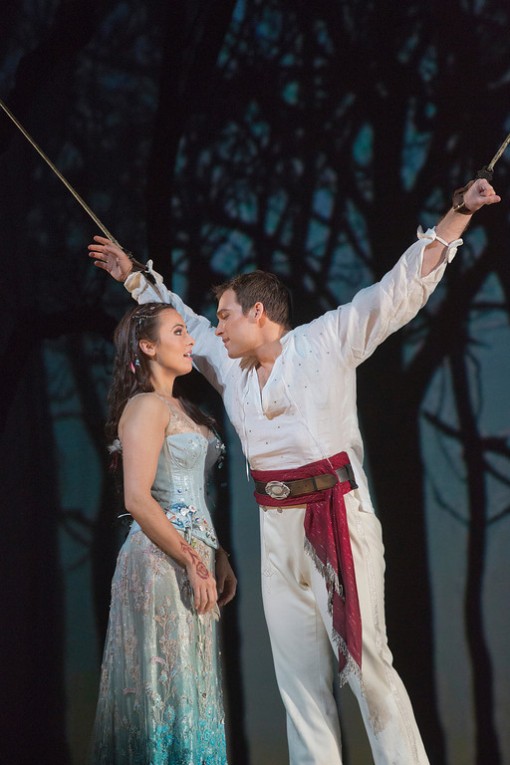Dazzling and deep, Adès’ “Tempest” creates a beautiful storm in Met premiere

Simon Keenlyside as Prospero and Audrey Luna as Ariel in Thomas Adès’s “The Tempest.” Photo: Ken Howard/Metropolitan Opera
There was a disclaimer missing in the program to Tuesday’s Metropolitan Opera premiere of Thomas Adès’ The Tempest: No sopranos were harmed during the making of this opera. As a result, audience members were left to fret over the vocal health of Audrey Luna, who in the role of Ariel was given one of the most extraordinary high, weird and difficult soprano parts on record.
Then again, Shakespeare calls for “solemn and strange music” in his 1612 play about a group of humans and spirits made to share an island in the wake of a shipwreck. In Adès’ adaptation, which was premiered at Covent Garden in 2004, the 41-year-old English composer provides both, along with sharp psychological insight, humor, magic, and a lingering air of melancholy. Shot through with the archaic beauty of Meredith Oakes’ libretto and brought to life in a dazzling and thought-provoking production by Robert Lepage, The Tempest is one of the most satisfying operas to blow onto the stage of the Met in years.
Adès and Oakes condense Shakespeare’s five acts into three. Prospero is the usurped ruler of Milan who was cast out on a rotting ship with his young daughter, Miranda. Endowed with magical powers, he now lives on an island with the teenage Miranda and two subservient creatures, the spirit Ariel and Caliban, who sees himself as the rightful lord of the island. Providence and a self-made storm bring Prospero’s antagonists to the shore, along with Ferdinand, the son of the King of Naples. Despite Prospero’s efforts Miranda and Ferdinand fall in love. After a day of scheming, plotting and magical revelations, Prospero extends blessings and forgiveness and the human characters board the ship bound for home.
In Lepage’s production, the island is a stage—literally, as he has set designer Jasmine Catudal rebuild the Baroque interior of Milan’s Teatro alla Scala. In the first act, the audience looks across the stage into the auditorium; in subsequent scenes the vantage point is flipped and rotated, offering frontal and side views of the “stage.” Kym Barrett’s costumes also evoke the eighteenth century, although Prospero’s naval coat is in such tatters that his naked, heavily tattooed, torso shows through. In a departure from Shakespeare, a chorus of elegantly dressed ship’s passengers adds a universal note and holds up a mirror to the audience.
Musically, Adès, who also conducted his work, is so adept at creating shifting sound worlds and evoking the exotic charms of Shakespeare’s island that you barely notice the lack of melodies. The score’s power come from the assured use of texture and color as well as the distinct and psychologically astute voices Adès tailors to his characters.
The most extreme of those is Ariel’s. Adès seems to have taken the coloratura passages of Mozart’s Queen of the Night as a starting point and added jagged intervals and extreme speeds and dynamics. Words barely come through at such altitudes, but then Ariel seems to inhabit a space of pure music. Luna, clad in a skintight hooded catsuit, not only sang each note with eerie precision but delivered them in precarious poses that showed off her dancer’s flexibility. In the high register, her voice sounded like latex: high-gloss, flexible, and thoroughly alienating.
Miranda, sung by Isabel Leonard with a warm and pure sound, is given the most consistently lyrical music. When she sings of her island home, her voice and the orchestra move as one. Prospero’s lines mostly seem to fight it and are often accompanied by a rough combo of tuba and timpani that evoke the opening storm music. The role was written for Simon Keenlyside, who has distinctly colored registers, his upper range warm and generous, his lower notes gruff. In a cast stocked with excellent male voices, his bearing and gestures had a practiced authority.
Among the male characters, William Burden’s King of Naples impressed with his tenderness and unforced power. Iestyn Davies as Trinculo and Kevin Burdette as Stefano made a finely tuned comic duo who seemed to enjoy the hiccups and drunken melisma Adès writes into their parts. Alek Shrader in his company debut found the balance between simplicity and nobility in the role of Miranda’s lover Ferdinand.
In an opera where every character is changed, Alan Oke’s Caliban underwent the greatest musical transformation. “You taught me language, and my profit on’t is I know how to curse,” he complains in Shakespeare. For the first two acts Adès gives him music that is deliberately ungrammatical, with humble vocal lines that Oke delivered in a flattened, speech-like voice. But when he tells of his dreams, he is allowed to sing some of the most classically beautiful lines of the opera and in the end, as he resumes control of the island, his voice is allowed to glow and expand. The final notes, though, float from somewhere high up in the auditorium, where Ariel, released from bondage, celebrates her freedom with sweet, effortless, music.
The Tempest will be performed again at the Metropolitan Opera on October 27 and 31 and November 3, 6, 10, 14 and 17. The performance on November 10 will be transmitted live in HD. metopera.org; 212-362-6000.

Isabel Leonard as Miranda and Alek Shrader as Ferdinand in Thomas Adès’s “The Tempest.” Photo: Ken Howard/Metropolitan Opera